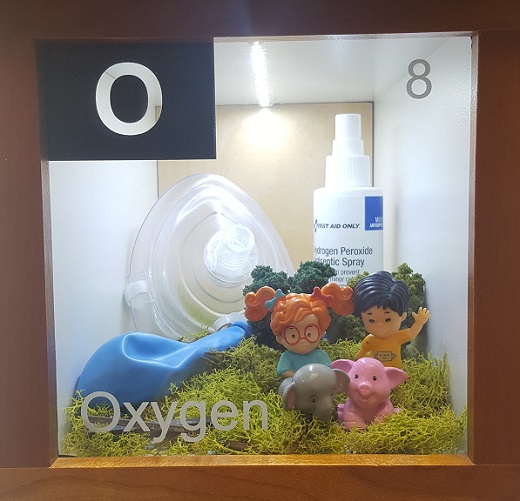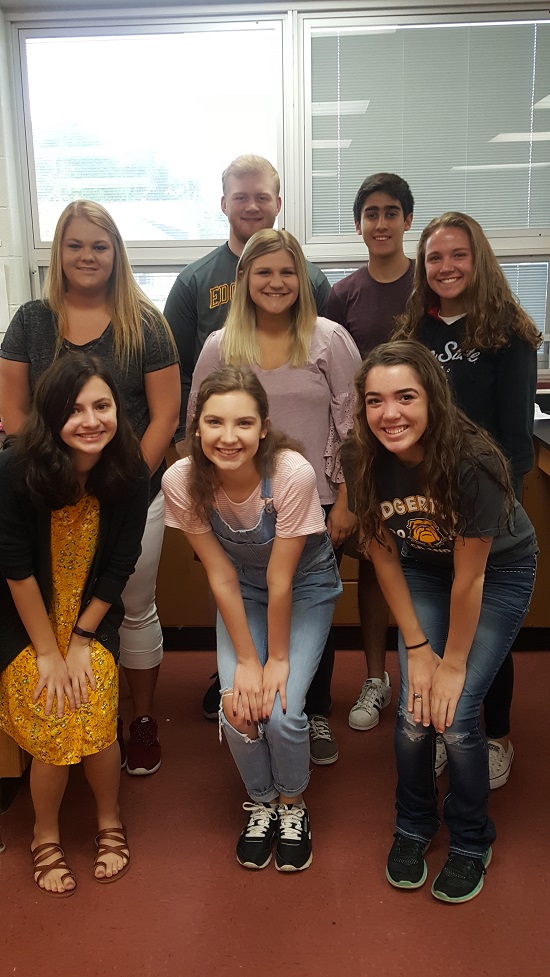Oxygen

Contributor: Olivia Schaffner's Chemistry class, Edgerton High School
About the Display: The display features
- OxiClean: As the infomercials say, OxiClean uses “the power of oxygen” to remove stains from fabrics and other surfaces. It contains sodium percarbonate, which is a chemical mixture of sodium carbonate (Na2CO3) and hydrogen peroxide (H2O2). When it is dissolved in water, it splits into sodium carbonate and hydrogen peroxide, each of which works to remove different types of stains. Specifically, the oxygen in the hydrogen peroxide works to break the chemical bonds present in the substances causing the stains. (not currently in box)
- Rusted iron nails: Rust consists of hydrated iron (III) oxide (Fe2O3·nH2O), iron (III) hydroxide (Fe(OH)3), and/or iron (III) oxide hydroxide (FeO(OH)). It is formed through the redox reaction of iron and oxygen in the presence of water.
- Plastic water bottle: Generally, plastic water bottles are made of a plastic called polyethylene terephthalate (PET). Plastics are polymers, which are very large molecules usually consisting of a single unit (called a monomer) that is repeated over and over again in a long chain. The single unit can be simple or complicated, and its structure is what makes various plastics differ from one another. Carbon atoms form the backbone of plastic polymers, with hydrogen atoms – and sometimes oxygen, nitrogen, chlorine, or other elements – attached. The single unit repeated to form PET has the formula C10H8O4, so this particular plastic does contain oxygen. (not currently in box)
- Water: Water has the formula H2O, meaning that it consists of one oxygen atom bonded to two hydrogen atoms. This makes pure water about 89% oxygen and 11% hydrogen. (not currently in box)
- Oxygen mask: An oxygen mask covers the mouth and nose and can be connected to a tank or can be breathed into by another person, in order to supply oxygen to a person in an emergency.
- Quartz: Quartz is a mineral containing silicon and oxygen. It’s composed of repeating structures of SiO4 tetrahedra – a silicon atom with four oxygen atoms bonded to it. However, since each oxygen atom is shared by two silicon atoms, its overall chemical formula is SiO2. (not currently in box)
- Steel darts: Oxygen has several important uses in the steel industry. The process used most often for steel production involves the basic oxygen furnace, in which oxygen is used to increase both the rate of combustion and the heat produced by it, in order to decrease the amount of impurities in the metal. (not currently in box)
- People: First of all, humans are made up of about 70% water, which contains oxygen, as explained above. Second of all, humans need oxygen to live in that it is used in the process of cellular respiration; in this process, oxygen reacts with glucose from the foods we eat to produce carbon dioxide, water, and energy. The carbon dioxide produced is needed by plants, and the energy produced is needed for other processes that must be carried out in humans themselves.
- Animals: Like humans, animals need oxygen to live because their cells undergo the same process of cellular respiration as humans, as described above.
- Trees: Plants undergo a process called photosynthesis, which is the opposite of the process of cellular respiration undergone in humans and animals. In photosynthesis, light energy from the sun allows carbon dioxide to react with water to produce glucose and oxygen. The oxygen produced is needed by humans and animals.
- Rock: Oxygen is the most abundant element in the earth’s crust, meaning that it is present in large amounts in rocks and soil. Different types of rocks contain different oxides, or compounds consisting of other elements bonded to oxygen. (not currently in box)
- Box of matches: The matches are meant to represent fire, or combustion, which is the rapid reaction of a material with oxygen. A match head consists of phosphorus, sulfur, and potassium chlorate (KClO3); the phosphorus is highly combustible and is ignited by friction, generating heat that breaks down the potassium chlorate, which produces more oxygen than is available in air, and this oxygen reacts with sulfur, which acts as the fuel that keeps the flame burning for long enough to light something else. (not currently in box)
- Balloon filled with air: Although many people consider “air” and “oxygen” to be one and the same, air is actually only about 21% oxygen.
- Hydrogen peroxide: Hydrogen peroxide has the formula H2O2 and contains about 94% oxygen.
Fun Facts:
- Oxygen is the third most abundant element in the universe, by mass.
- Oxygen is pale blue when in liquid or solid form.
- Oxygen is the most abundant element in the earth’s crust; over 46% of the weight of the earth’s crust is oxygen.
- Approximately two-thirds of the mass of the human body is oxygen.
- Some of the colors of the aurora borealis (the northern lights) and the aurora australis (the southern lights) are due to oxygen. These phenomena occur when fast-moving electrons from the sun enter earth’s atmosphere near the north and south poles. The electrons impart energy to oxygen and nitrogen atoms in the atmosphere and “excite” them; when the atoms return to their normal state, they give off this energy as light. Oxygen atoms in the upper atmosphere emit the red light seen in the auroras, and oxygen atoms in the lower atmosphere emit the more commonly seen green light.
About the Contributor: Ms. Schaffner’s 1st period Chemistry class from Edgerton High School in Edgerton, Ohio, has 8 sophomores, juniors, and seniors in it (including one exchange student from Mexico!). Pictured in the front row are Alivia Wheeler, Olivia Hennessey, and Madison Freeman. Pictured in the middle row are Bree Hug, Hannah Sleesman, and Emma Siebenaler. Pictured in the back row are Ethan Brown and Sebastián Barron.

Back to the Periodic Table
Symbol: O
Atomic Number: 8
Atomic Mass: 15.999 u
Electron Configuration: [He]2s22p4
Year Discovered: 1774
Discovered By: Joseph Priestly and Carl Wilhelm Scheele


